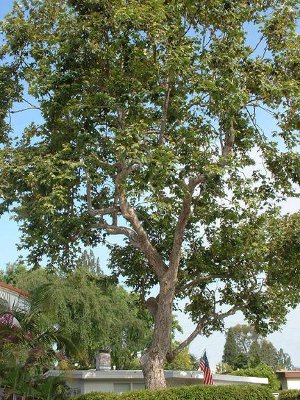California Sycamore Tree
Category: Deciduous Trees

Facts about California Sycamore Tree, "Scientific name for California Sycamore Tree is Plantanus racemosa". California Sycamore Tree is a species of the sycamore tree. It also has other names such as California plane tree, Western sycamore among others. The California Sycamore Tree is native to California and grows in canyons, springs, floodplains and seeps. You can also find it along rivers and streams.
Physical Description of California Sycamore Tree
The California Sycamore Tree grows to a height of 35 meters which is approximately 110 feet (33.52 meters). The diameter of its trunk measures (1 meter). The trunk then splits into other sub-trunks resulting into more branches as the California Sycamore Tree grows. The bark consists of an attractive patchwork of pinkish gray, white and tawny beige. As the bark becomes older, it turns darker and starts peeling away.
The leaves of California Sycamore Tree
The leaves are palmate, lobed and measure about (25 cm) in width. As the leaves sprout, they assume a wooly and bright translucent green coloration. The California Sycamore Tree is a deciduous tree and as such, it drops leaves that are usually orange to red in color during the fall season.
Flowers and fruits of California Sycamore Tree
The spherical flower heads that characterize the blooming of the California Sycamore Tree measure about one centimeter in width. The female flower heads eventually develop into clusters of spherical fruits consisting of many hairy and maroon red achenes.
California Sycamore Tree leaves are made up of many colored pigments, green chlorophyll hides the colors during the growing season of spring and summer. As days get Shorter and cooler temperatures come in the fall, it cause the chlorophyll to break down and than the other color pigments can be seen.
California Sycamore Tree growth is referred to as Meristem (The undifferentiated embryonic plant tissue from which new cells are created, as that at the tip of a root or stem). This tissue can be found at the tips of shoots and leaves. Inside the stem growth in thickness occurs at the vascular cambium.
California Sycamore Trees make their own food from sunlight, carbon dioxide, water, and nutrients from the soil.
Uses of California Sycamore Tree
The wood of the California Sycamore Tree is coarse grained and very difficult to split. The California Sycamore Tree comes across as a very resourceful plant that is often used as a meat preparation surface in butchers. Also small birds feed on its fruit while other mammals eat its twigs and the bark. For people who have asthma and other allergic tendencies, the hairs and the pollen produced by the California Sycamore Tree may affect them.
California sycamore tree is usually planted as a landscape tree mostly in public places and at times in private gardens. During summer, it provides awesome shade while in winter, it lets in sunlight. This property has made it to be used in sustainable design and green architecture.
California Sycamore Tree roots usually grow two to three times the width of the tree branches. The ideal time to fertilize your California Sycamore Tree is in late fall or early spring. If you want to transplant a California Sycamore Tree do it in fall, this is ideal for most trees.
A Full grown California Sycamore Tree can absorb as much as 48 pounds (21.77 kg) of carbon dioxide a year. The same California Sycamore Tree could also produce enough oxygen in a day for two people. In a single day, a large California Sycamore Tree can drink up to 100 gallons (378.5 liter) of water from the ground and discharge it into the air.
You can tell a California Sycamore Tree age by the number of growth rings. Growth rings size shows what kind of conditions accrued that year, the temperature and if it was a dry or wet year.
Bark of the California Sycamore Tree protects it from the elements and is made up of dead cells.

 Back To Category Deciduous Trees
Back To Category Deciduous Trees